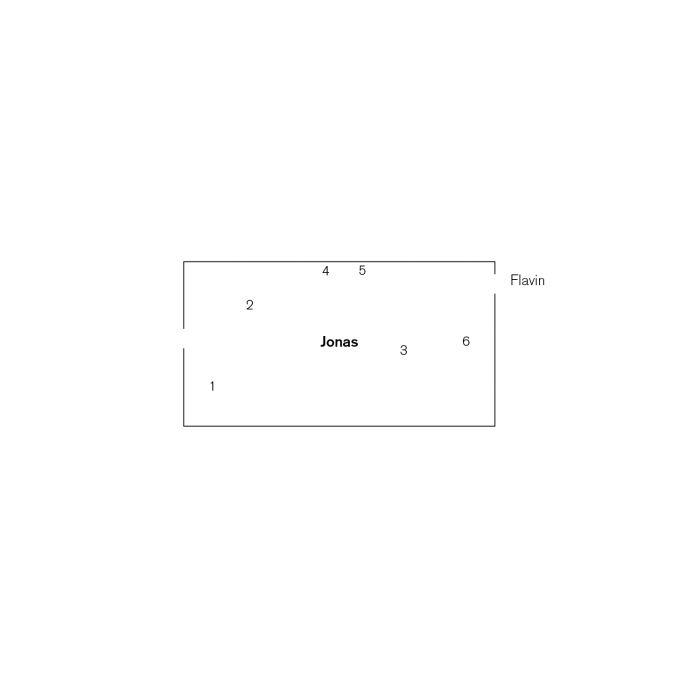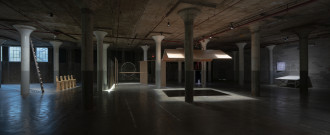Joan Jonas
October 8, 2021–March 13, 2023, Dia Beacon
Overview
This exhibition brings together three collection works by Joan Jonas, a founding figure of video and performance art of the 1960s and 1970s. Presented in Dia Beacon’s lower-level galleries, the exhibition features the large-scale multimedia installation The Shape, the Scent, the Feel of Things (2004), which was commissioned as a performance for Dia Art Foundation in 2005–06, and two recently acquired works, Stage Sets and After Mirage (Cones/May Windows) (both 1976). Collectively, the three works present a compelling trajectory of Jonas’s oeuvre from the pivotal year of 1976, when Jonas decisively turned to translating nonlinear performance and video into performance installations, to the evolution of the artist’s work thirty years later.
Joan Jonas is made possible by significant support from the Kaleta A. Doolin Foundation and Barbara Gladstone. Generous support is provided by Karyn Kohl. Additional support is provided by Sara H. Arison, Agnes Gund, Marguerite Hoffman, Kramlich Art Foundation, Kelsey Lee Offield, Erica Samuels, David Schwartz Foundation, Inc., and Jamie and Robert Soros.
In 1976 Joan Jonas began adapting her performances into durational installations. With each installation, the artist reclaims components and ideas from preceding works and reanimates them in an evolving self-reflexive process. This presentation of Jonas’s work unites the large multimedia installation The Shape, the Scent, the Feel of Things (2004) with two of the artist’s earliest installations Stage Sets and After Mirage (Cones/May Windows) (both 1976). Collectively, these three projects chart a trajectory of the artist’s practice from the genesis of installation in her work to its continuing regenerative development decades later.
Regarded as key to the evolution of video and performance art, Jonas’s radical works from the 1960s and ’70s are closely linked with the simultaneously emerging field of feminist critique. Her textured installations involve drawings, sound, video, and sets, often activated through performances that feature the artist and her collaborators using and reusing props such as masks and mirrors. Drawing on her own experiences, Jonas often investigates and incorporates various performance practices, films, texts, objects, and other sources she encounters. To name only a few examples, details ranging from singer Kate Fenner performing a Woody Guthrie song, objects collected from Jonas’s travels, and a found taxidermied coyote all feature in this exhibition alone.
Stage Sets (1976) is composed of a series of props and drawings from Jonas’s videos and earlier performances. For example, this installation includes copies of the antique accountant’s chair that she used in a series of performances and videos from 1972 where she assumed the mystical persona Organic Honey. Stage Sets incorporates a hanging metal hoop and temporary walls constructed from suspended paper, both of which she first employed in her performance Funnel (1974). Here, six nine-foot-tall metal cones—previously used like megaphones in the performance Mirage (1976)—illuminated from within and suspended two inches above the floor, evoke lamps. When Stage Sets was first presented at the Institute of Contemporary Art, Philadelphia, in 1976, the work served as the backdrop for Mirage and the first version of her performance The Juniper Tree (1976).
Jonas initially repurposed the cones from Mirage in a 1976 untitled improvisatory performance done in collaboration with artist James Nares. There, Jonas and Nares again used the objects like megaphones and swung them around the space. Mirage ultimately evolved into the installation After Mirage (Cones/May Windows), which features the metal cones arranged in a circle alongside a duplicate set of paper cones. Both formations are paired with video monitors. The screens, resting on their sides, play Jonas’s video May Windows (1976), in which the cones also appear. Shot with an exaggerated exposure, the video shows a flattened and blurred high-contrast image of the artist in front of her studio window. She moves, animating the space, and makes various sounds such as whistling and blowing air. She also selectively invites noise in from outside by opening and closing the window. In doing so, the artist blends controlled and spontaneous sounds from both seen and unseen sources. By distorting her body and gestures, she disperses herself into the environment.
Although Stage Sets and After Mirage (Cones/May Windows) are singular installations, a layered history of Jonas’s oeuvre is also embedded in these works. They index antecedents as well as artworks from the decades to follow including The Shape, the Scent, the Feel of Things. In 2004 Dia Art Foundation commissioned that performance, which was staged in Dia Beacon’s lower level in 2005 and 2006. Jonas based the commission on a lecture by German art historian and theorist Aby Warburg titled “Images from the Region of the Pueblo Indians of North America,” which he presented in 1923 at Kreuzlingen Sanatorium in Switzerland where he was a patient.[1] Inspired by his travels to the southwestern United States nearly three decades earlier, “Images” centers on a description of the Hopi Snake Dance, a ceremonial ritual performed with live snakes. Although Warburg never witnessed it, his description draws on photographs, ethnographies, and other accounts, and he uses this rite as an entry point to trace a visual, cultural, and mythological history of serpent imagery. Jonas was particularly interested in the considered way he describes the dance, which she had herself observed in her own travels to the region. He elaborates on and pursues small details, mapping the performance through interwoven cultural features.
Just as Warburg built a speculative and entangled history through his lecture, Jonas similarly blends personal and cultural history in response to his text. Immersing the art historian’s realizations and biography within a larger visual display of cross-cultural manifestation, her multimedia performance illustrates her rereading and recasting of the text. About The Shape, the Scent, the Feel of Things, Jonas writes: “In a sense, I am approaching an old experience, as Warburg did, decades later through new work, for which the words are not yet completely present.”[2] Using projections, objects, and photos, Jonas layers an extensive range of images, including ones of Albrecht Dürer’s engraving Melencolia I (1514), landscapes of the southwestern United States, her own sketches, and even the lower level of Dia Beacon. Through desynchronized collection, Jonas conjures a hallucinatory space with voiceovers, dance, drawing, and an original score by jazz musician Jason Moran. As part of each performance, the artist makes a gestural drawing of a white line or snake on black paper, three of which are on display in conversation with the installation.
In keeping with her ongoing, iterative practice, Jonas reconsidered The Shape, the Scent, the Feel of Things for this exhibition. Here, she highlights a video clip from the original piece and isolates it as a new discrete projection. The reel is shot from Jonas’s perspective as she explores the abandoned, defaced, and boarded-up shorefronts of the Salton Sea, a once-popular resort destination in southern California. The body of water has, over the last half-century, both shrunk in size and grown increasingly toxic to its surrounding community. Jonas’s constant reimagining of her own works allows her to continuously expand her practice and respond to her own unfolding interpretations and ideations, reengaging and reinventing her own past.
–Theodora Bocanegra Lang
Support provided by Bloomberg Philanthropies
Directed and edited by Graham Mason
Director of Photography: Ian McAlpin
Sound Mixer: Ryan McGlade
Original music for interview video composed by Bennett Young
Piano score for The Shape, the Scent, the Feel of Things composed and performed by Jason Moran
Interview conducted by Kelly Kivland
Dia Project Staff: Karey David, Katherine Ellis, Laura Fields, Hannah Gompertz, Jenn Kane, Kelly Kivland, Theodora Bocanegra Lang, Deirdre O’Dwyer, and Dan Wolfe
Special thanks to Joan Jonas
© 2022 Dia Art Foundation
All works by Joan Jonas © 2022 Joan Jonas/Artist Rights Society (ARS), New York

- Stage Sets, 1976/2018
Kraft paper, pine wood, felt, steel, cotton velvet, glass mirror, cotton-rag paper, Latex on pine wood, chalk on wall, and china marker on wood and paper
Dia Art Foundation - After Mirage (Cones/May Windows), 1976
Cold-rolled steel, cotton-rag paper, and video (May Windows, black-and-white, with sound, 14 min., 2 sec.) on monitors
Dia Art Foundation - The Shape, the Scent, the Feel of Things, 2004
Color video projections (Beacon footage, 29 min. 44 sec.; Electric fires, 4 min. 21 sec.; Melancholia, 5 min., 12 sec.; Mirror Improvisation, 6 min., 36 sec.; Wolf Lights, 2 min., 50 sec.; Salton Sea, 6 min. 38 sec.; 2005 Dia Beacon performance, 80 min., 7 sec.; distributed stereo sound), and props from original performance
Edition 2 of 3
Gift of Jessica E. Smith and Kevin R. Brine to Dia Art Foundation and the Whitney Museum of American Art
- Performance drawing from The Shape, the Scent, the Feel of Things, 2005
Acrylic on paper
Courtesy the artist and Gladstone Gallery - Performance drawing from The Shape, the Scent, the Feel of Things, 2005
Acrylic on paper
Courtesy the artist and Gladstone Gallery - Performance drawing from The Shape, the Scent, the Feel of Things, 2005
Acrylic on paper
Courtesy the artist and Gladstone Gallery
Joan Jonas was born in New York in 1936. She received a BA from Mount Holyoke College, South Hadley, Massachusetts, in 1958, and an MFA in sculpture from Columbia University, New York, in 1965. Her work has been exhibited internationally, with recent solo exhibitions at the Tate Modern, London (2018); Isabella Stewart Gardner Museum, Boston (2019); Fundação de Serralves, Porto, Portugal (2019); and Museo Nacional Thyssen-Bornemisza, Madrid (2020). Jonas represented the United States at the 2015 Venice Biennale and received the Kyoto Prize in 2018. Jonas is Professor Emerita at Massachusetts Institute of Technology, Cambridge.
Artist
Joan Jonas
Joan Jonas was born in New York City in 1936, where she currently lives and works.
Selected Works on View

Joan Jonas
The Shape, the Scent, the Feel of Things, 2004
Go to The Shape, the Scent, the Feel of Things page
Joan Jonas
Stage Sets, 1976/2018
Go to Stage Sets page
Joan Jonas
After Mirage (Cones/May Windows), 1976
Go to After Mirage (Cones/May Windows) pageExplore
Joan Jonas: next move in a mirror world Book Launch
Move to Joan Jonas: next move in a mirror world Book Launch page
Joan Jonas Knowledge Base Launch Event
Move to Joan Jonas Knowledge Base Launch Event pageJoan Jonas Knowledge Base Launch Event
Move to Joan Jonas Knowledge Base Launch Event page



